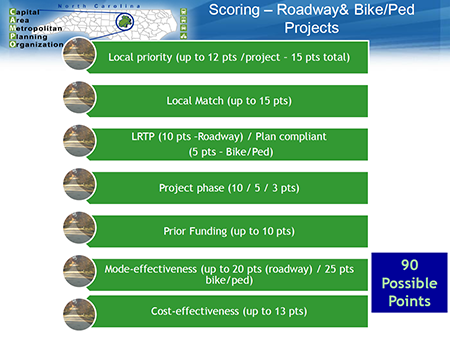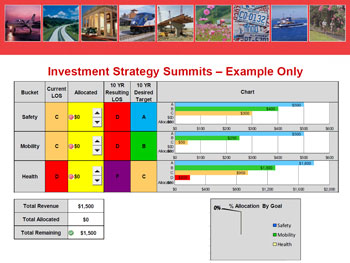On July 10-11, 2012, CMAP hosted a peer exchange event through the Federal Highway Administration (FHWA)/Federal Transit Administration (FTA) Transportation Planning Capacity Building program. This event focused on the use of performance-based evaluation criteria in the evaluation and funding of transportation projects. The participating peer agencies included three metropolitan planning organizations (MPOs) paired with their three state departments of transportation (DOTs). This pairing provided two sets of perspectives on the same performance management system. The peer agencies included the Minnesota DOT and Metropolitan Council (Minneapolis-St. Paul-area MPO), the North Carolina DOT and Capital Area MPO (Raleigh-area MPO), and the Pennsylvania DOT and Delaware Valley Regional Planning Commission (Philadelphia-area MPO). Additional attendees included staff from CMAP and the Illinois DOT (IDOT), along with a representative from the Illinois MPO Advisory Council. The presentations from the peer exchange are available from CMAP's FTP websiteftp://ftp.cmap.illinois.gov/Volpe_Peer_Exchange/. The public login name is "cmapftpro" and the password is "CMAPread2013".
The peer agencies are national leaders in performance management and the linking of performance data to the programming of transportation funds. Although the peers represent a variety of contexts, including both centralized and decentralized DOTs, their experiences offer many similarities. These commonalities suggest next steps toward implementing performance-based programming in Illinois.
CMAP applied to the U.S. DOT to host this peer exchange as part of its ongoing work on performance measures. GO TO 2040 recommends that transportation funding decisions be based on transparent evaluation criteria and that IDOT and the region's transportation stakeholders develop and utilize the necessary performance measures. Additionally, GO TO 2040 specifically targets the longstanding "55/45 split" in highway funding for Illinois, which directs 45 percent of highway funds to the Chicago region and 55 percent downstate, regardless of need. CMAP staff prepared an Issue Brief on the topic in May 2012, and has presented initial research findings to the CMAP Board and MPO Policy Committee. The CMAP Board sent a letter to IDOT and the Regional Transportation Authority in January 2012, requesting to work collaboratively on the implementation on performance-based transportation funding systems.
In the next few weeks, staff from the Volpe National Transportation System Center will issue a written report summarizing the peer exchange event on the Transportation Planning Capacity Building program's website. Until that report becomes available, CMAP staff has summarized the major lessons learned from the peer exchange into five categories: transparency, DOT-MPO relationship, de-politicization of the process, implementation, and measures and targets.
Transparency
All peer agencies illustrate exemplary transparency both in their use of performance data and throughout the programming process. On the data side, peer agencies reported extensive and ready data sharing among DOT and MPOs, as well as public and regular performance reporting of key indicators through a variety of formats. Their performance-based systems include explicit weighting of performance criteria, which are publicly documented. Project scores and rankings demonstrate a clear, defensible rationale to the public as to why a given project was selected for funding.
On the process side, peer agencies presented straightforward, intuitive explanations of the programming process to the public through websites, booklets, and other publications. State DOTs reported a strong level of outreach to MPOs, local implementing agencies, and the public in developing transportation programs, as well as extensive coordination with MPOs and meaningful consideration of their input. Peer agencies effectively incorporate technology into the process, promoting data visualization and data sharing. For example, an online "calculator" tool from the North Carolina DOT allows stakeholders and the public to understand the tradeoffs inherent in programming decisions. An example of this tool is included as a standalone spreadsheet on the CMAP FTP site. The NCDOT website provides an overview of that state's prioritization process, including the scores and supporting data for specific projects.
This image from the NCDOT illustrates the interactive calculator-type tools used in its outreach efforts. Given a fixed budget, participants can allocate funds among three broad categories (safety, mobility, health) and see the resultant changes level of service. These outcomes are compared against ten-year goals.
DOT-MPO Relationship
Peer states demonstrate a healthy working relationship between the state DOT and MPOs. Their processes formalize MPO and local agencies' input into the process. For example, North Carolina allows MPOs to determine a portion of a project's score and provides greater weight to MPOs' input for regional projects. Further, peer states allow MPOs to nominate projects for programming. In the peer cases, state DOT and MPO staff meet regularly, in some cases for annual overnight conferences. These meetings build relationships and improve communication.
De-Politicization of the Process
In some states, transportation funding decisions had been highly politicized prior to the implementation of performance-based programming. Peer agencies reported that high levels of transparency and improved DOT-MPO relationships help to de-politicize the process. In an inclusive, performance-based system all stakeholders have ownership of the process. Because outreach and collaboration are genuine, the process is seen as credible and accountable by DOT and MPO staff, state legislators, local officials, and the public. Data is transparent and the process well-communicated – all stakeholders know the "rules of the game" and can see why some projects were chosen and others were not.
Performance-based programming also offers the promise of long-term equity. The process may not deliver a set level of funding to a jurisdiction in any given year, but that jurisdiction can reasonably expect to have its legitimate needs met when the time comes.
Implementation
The implementation of performance-based funding processes may represent a significant departure from past practice, making the experience of peer states is particularly instructive. Peer agencies reported that strong commitment is required from leadership of the state DOT. Executive leadership must have strong background in policy, and there must be a supportive culture of innovation within the agency. Further, appropriate staff capacity is necessary within state DOT. The staffing commitment to establish and operate performance-based funding is not necessarily high, although it is critical to have staff dedicated exclusively to this process.
It is important to get started with manageable steps and to view the implementation of performance-based funding as a process. No peer state applies performance-based programming to all its transportation funding sources, and it may be politically expedient to initially apply performance-based funding to new revenue sources only.
Measures and Targets
Successful implementation of performance-based programming ultimately depends on the performance measures and targets chosen. Peer agencies suggested it is important to have broad policy guidance from federal and state governments in setting performance measures and targets. Some peers organize funding into programmatic "buckets" similar to the approach offered in CMAP's issue brief on performance-based funding. This approach can allow a focused level of review commensurate with a project's scope and impact—the state DOT should be given considerable weight for Interstate projects, while MPOs should have considerable input for regional projects—as well as its work type. MPOs' input may not be as necessary in evaluating routine maintenance projects, but could be critical in evaluating expansion and modernization projects.

This image from the Capital Area MPO (CAMPO) in Raleigh, NC, illustrates the weighting of various criteria in the scoring of highway and bicycle/pedestrian projects.

This image from CAMPO demonstrates how points are awarded within the "Mode-effectiveness" category for highway projects. "V/C" refers to volume-to-capacity ratio; "CMP" refers to the Congestion Management Process.
Conclusion
The experience of peer agencies suggests two further points. First, all peer states use a two-year programming cycle, in contrast to the annual programming cycle in place in Illinois. This longer cycle may be necessary to complete a rigorous performance-based programming process (extensive data collection, public outreach, etc.). Second, in no state does the objective, performance-based score determine whether a project will be funded. Other considerations come into play, including project readiness and federal funding restrictions.
Moving toward performance-based transportation funding will remain a high priority for CMAP over the next year. Staff is currently meeting internally to discuss next steps, and these will likely include increased education and outreach to partners, as well as the initiation of new collaborative efforts between CMAP, IDOT, and the other Illinois MPOs. Staff will continue to update the CMAP Board, MPO Policy Committee, Regional Coordinating Committee, andTransportation Committee as this process moves forward.
